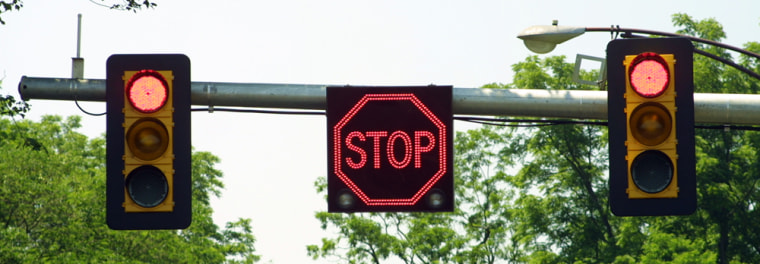Backed up at a traffic light? Frustrated when you hit a red light only a block after driving through a green? Odds are, those traffic signals may need some work.
A new survey being released Wednesday says the nation’s traffic signal operations are largely inefficient, leading to frustration and unnecessary delays for motorists, wasted fuel and more air pollution as vehicles constantly stop and go.
“Everyone knows the traffic signals turn red, yellow and green,” said Shelley Row of the Washington, D.C.-based Institute of Transportation Engineers. “It’s not about them changing colors. It’s about them operating efficiently.”
The survey, prepared by a coalition that included the Federal Highway Administration and various transportation groups, was based on surveys last fall of 378 traffic agencies in 49 states. It found:
- 68 percent said they have either no documented management plan for their traffic signal operation, or their plan is to simply respond to problem intersections as they happen.
- 71 percent don’t have staff to monitor traffic before and after normal working hours.
- 57 percent said they don’t conduct routine reviews of traffic signals within three years.
The report measured how traffic agencies manage their systems, review traffic signal timing, maintain an inventory of traffic data and provide adequate staffing. It contends there are not adequate resources for monitoring and coordinating traffic signals, and estimates that improving the system could cost roughly $965 million a year.
Many lights not timed
Many communities have not completed a systemwide retiming of their traffic lights in a decade, said Phil Tarnoff, director of the Center for Advanced Transportation Technology at the University of Maryland.
Others are “fighting fires,” Tarnoff said, targeting traffic buildups around certain busy intersections, a move that only pushes the tie-ups elsewhere.
“After you do that for a few years, you have a big mess on your hands,” Tarnoff said.
Bellevue, Wash., was the first community to have a centralized traffic computer for timing signals, and the system has been upgraded three times as the Seattle-area community has grown.
Mark Poch, the city’s traffic engineering manager, said the system — which connects to individual traffic cameras — allows them to adjust signals for traffic flows, emergencies and special events.
In Springfield, Mo., the city has used federal grants the past four years to begin to connect the traffic system throughout southwest Missouri.
Earl Newman, city assistant director of public works for traffic engineering, said it allows the office to coordinate traffic signals, visually monitor 28 miles of roads and issue traffic information to the public.
The group that compiled the survey included the FHA, the American Association of State Highway and Transportation Officials, the American Public Works Association, the Intelligent Transportation Society of America and the Institute of Transportation Engineers.
Respondents included state and local traffic agencies responsible for about one-third of all signals in the United States.
